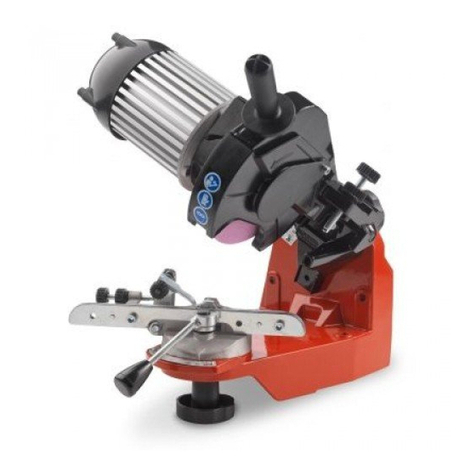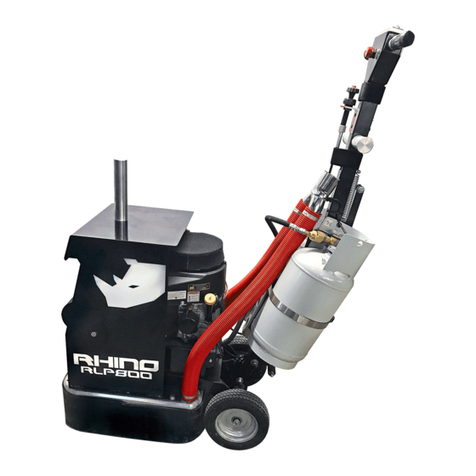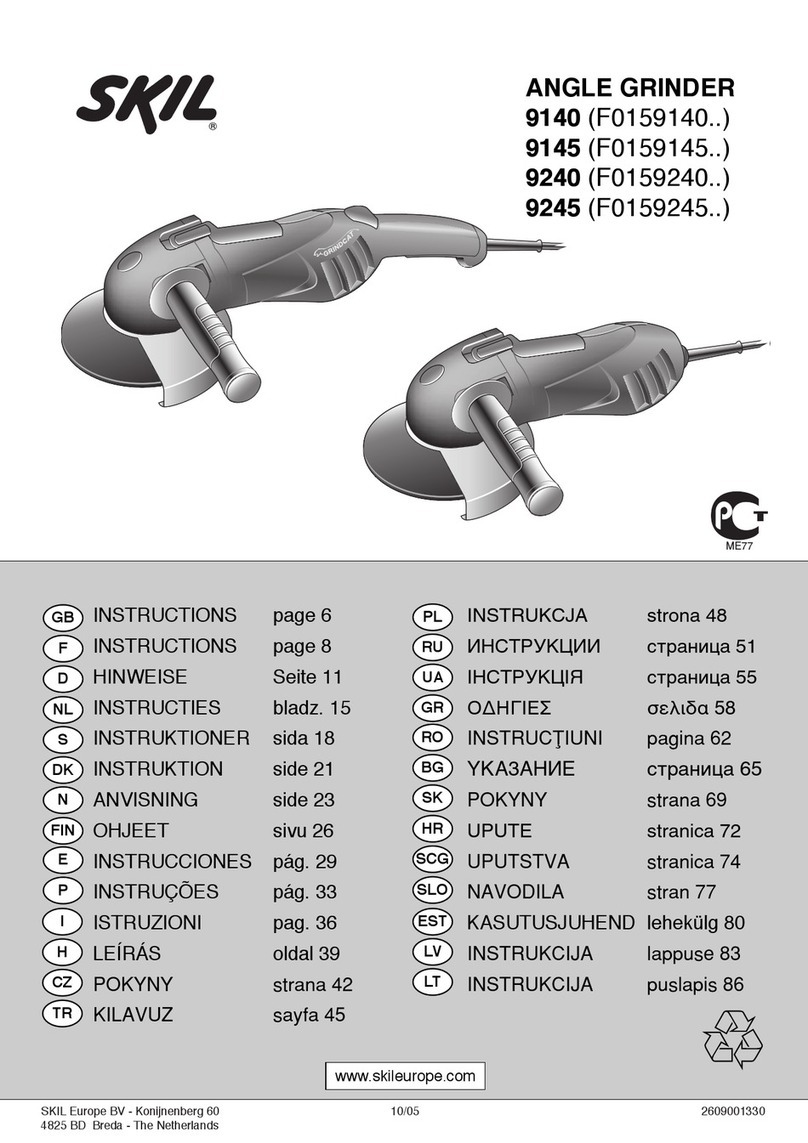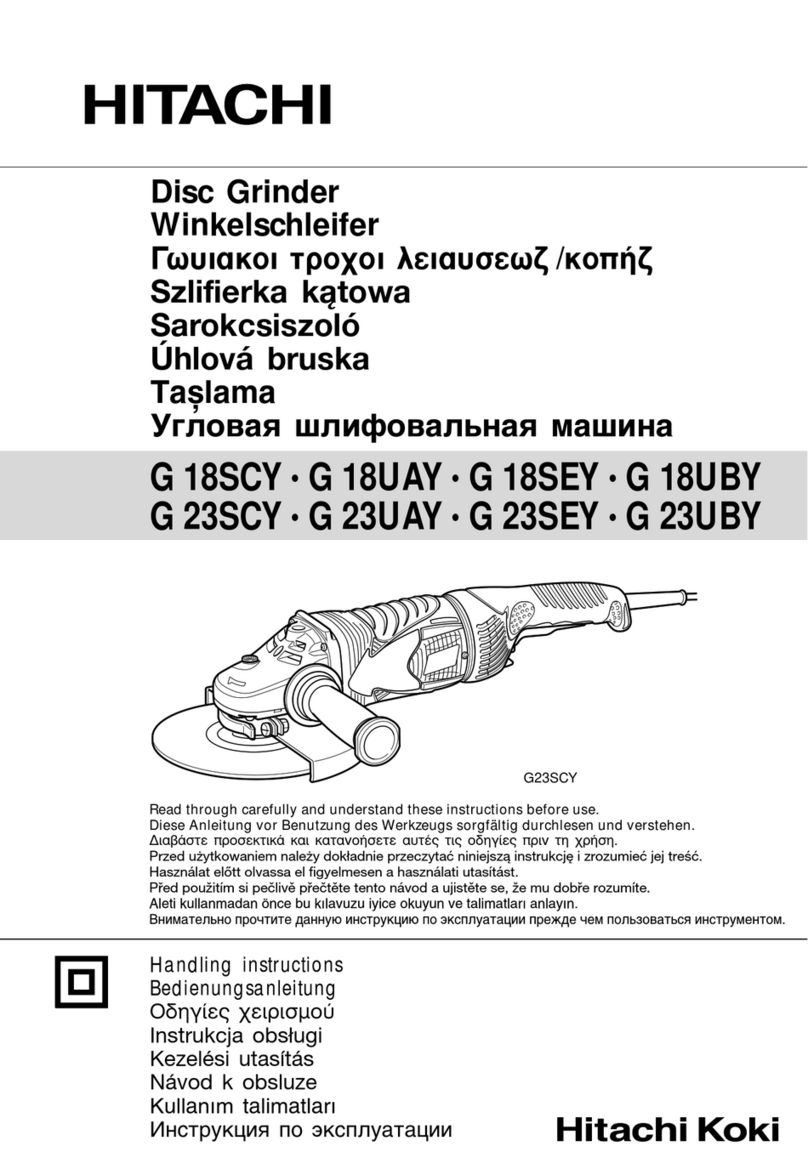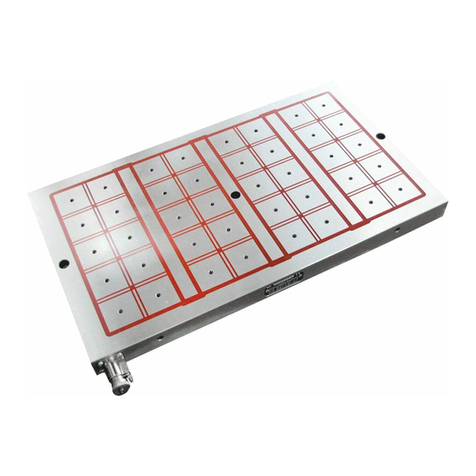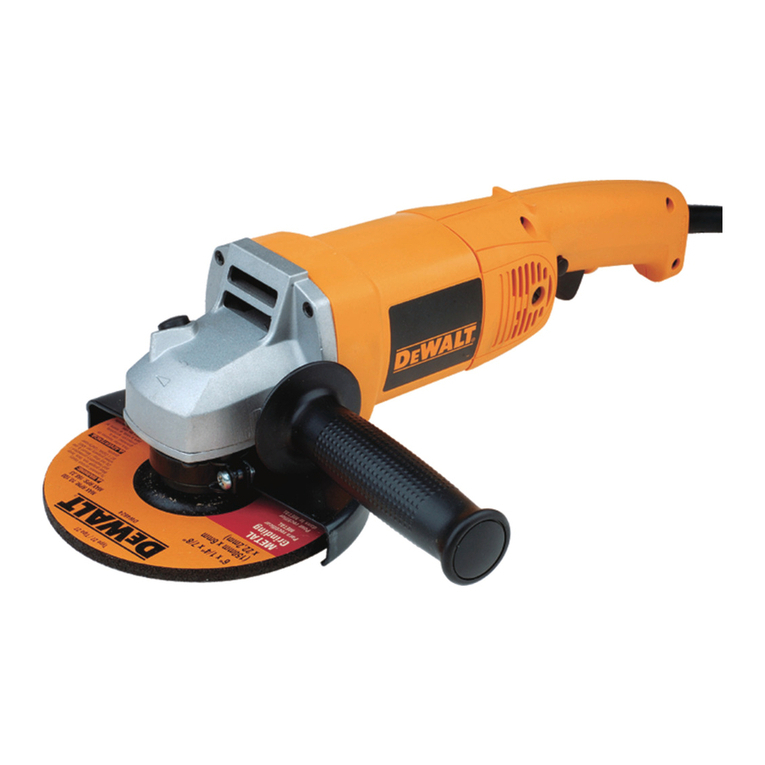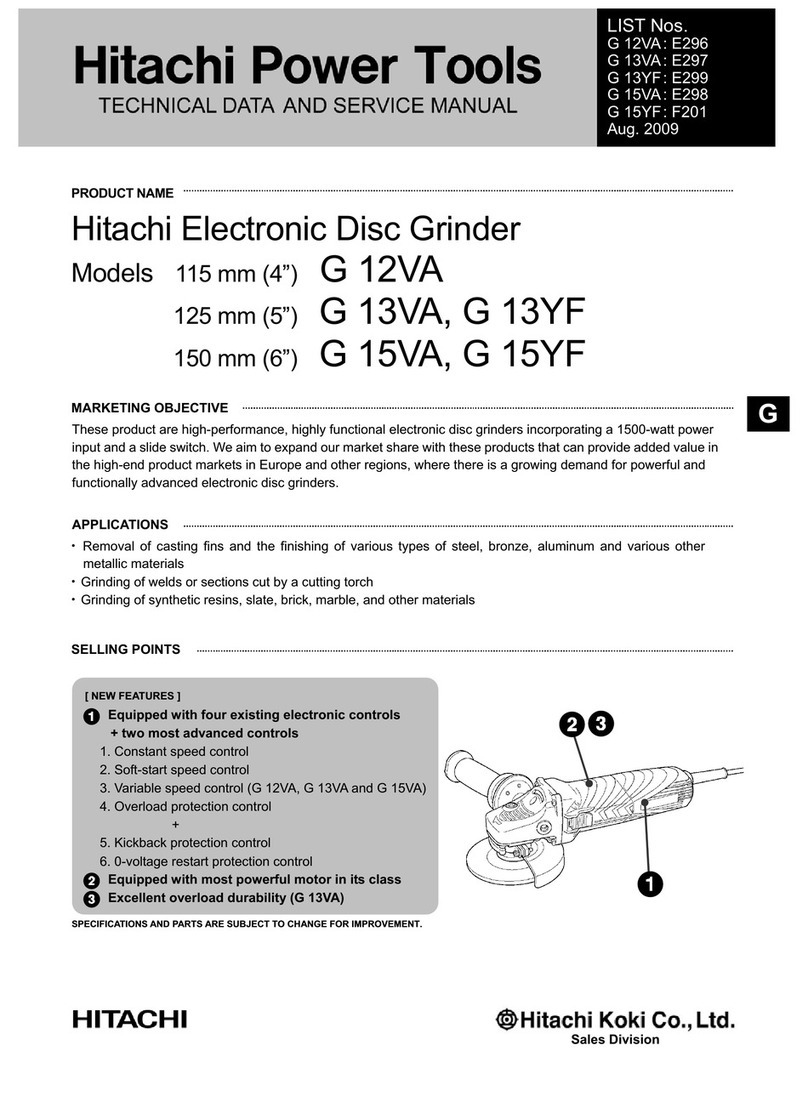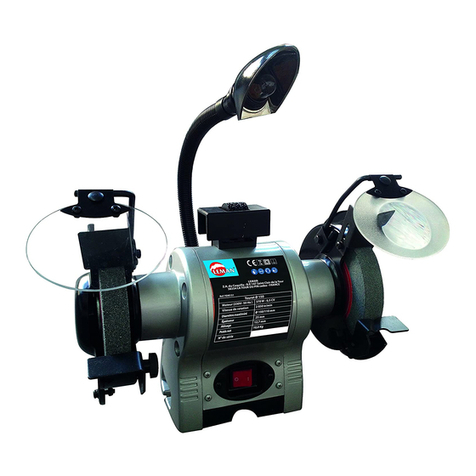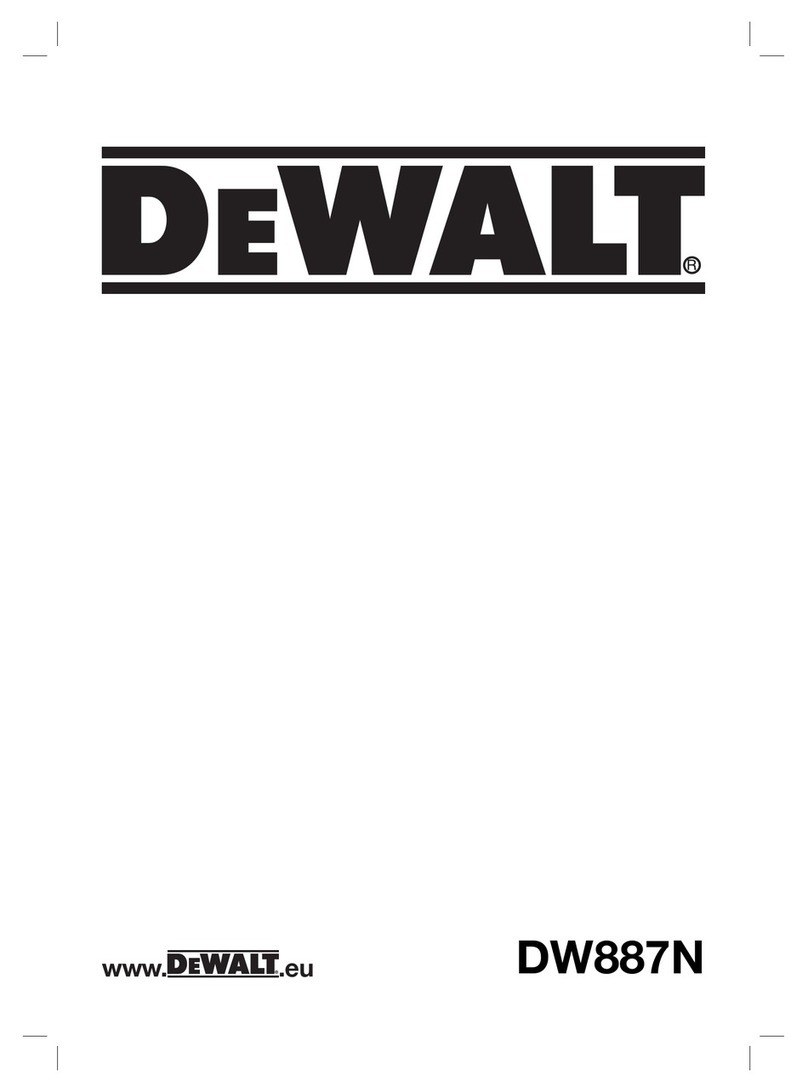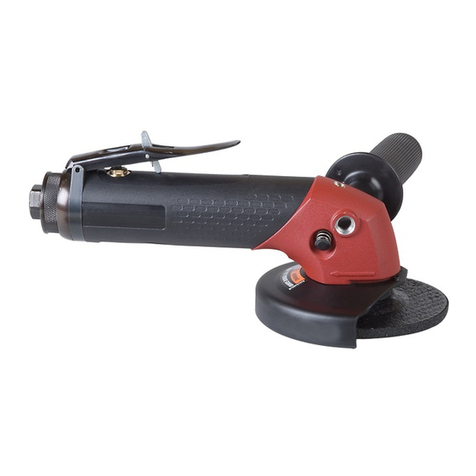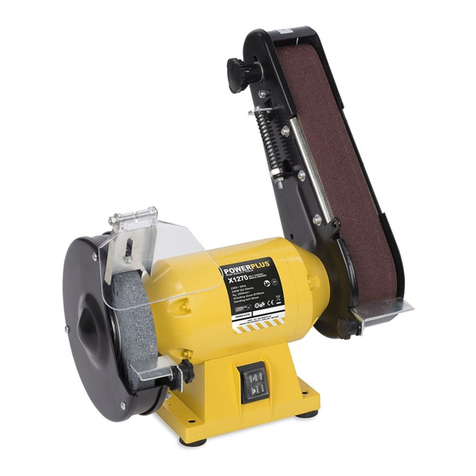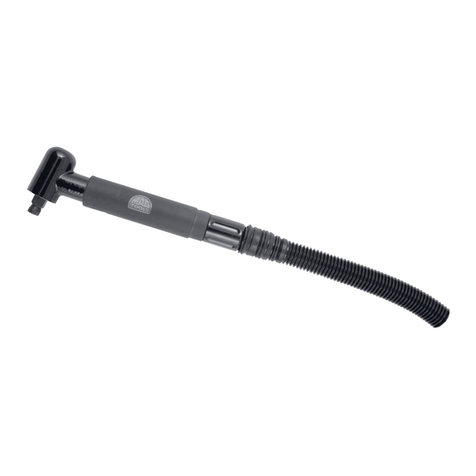Mako SROM 1183 User manual

Instruction Manual
115mm ANGLE GRINDER
Model SROM 1183
Our tool range has you covered for DIY. Whatever the job, make light work of
it with MAKO tools.

PRODUCT FEATURES:
1. Spindle Lock
2. On/Off Switch
3. Wheel Guard
4. Grinding Wheel
5. Auxiliary Handle
6. Clamping Nut
7. Mounting Flange
8. Wheel Guard Adjustment Screw
9. Wheel Guard Latch

Dear Valued Customer,
Thank you for purchasing this Mako Power Tool.
We are dedicated to providing quality Mako Power Tools at competitive prices. Whether you are
serious about DIY or just a casual user, our range of power tools are perfect for any job.
Mako 2 Year DIY Warranty:
All Mako Power Tools are backed by a comprehensive 2 year DIY warranty. If for any reason you
experience a fault with this power tool, please contact the retailer that it was purchased from, present
the receipt and warranty card (at the back of the operating manual), for a full refund or replacement.
The warranty is void if damage is not attributable to normal wear and tear, if the tool is used
commercially, the motor is overloaded or is tampered with, is damaged by accident or if it is bought
second hand. Continued use after partial failure, or the use with the incorrect accessories will void the
warranty.
This warranty excludes all Mako accessories, which are covered by their own appropriate warranties.
MAKO TOOLS ARE FOR DIY USE ONLY. THEY ARE NOT DESIGNED OR APPROVED FOR
INDUSTRIAL OR COMMERCIAL USE.

CONTENTS:
General Safety Rules
oWork Area safety
oElectrical Safety
oPersonal Safety
oPower Tool Use and Care
oService
Angle Grinder Safety Instructions
Mako Angle Grinder Operating Instructions
oAssembly
oOperation
oMaintenance & Cleaning
Mako Angle Grinder Technical Data
Description of symbols:
Please read all of the safety and operating instructions carefully before using
this Angle Grinder. Please pay particular attention to all sections of this User
Guide that carry warning symbols and notices.
Observe caution and safety notes!
Caution- electric shock! Danger to life!
n0No-load speed.
V~ AC Voltage
Wear hearing protection, dust protection mask,
protective glasses and protective gloves.
Keep children away from electrical power tools!
Only for use in dry, indoor spaces.
Check that the device, mains lead and plug are in good
condition!
Safety classⅡ
Dispose of packaging and appliance in an
environmentally friendly way!

GENERAL SAFETY INSTRUCTIONS
WARNING Read all safety warnings and all instructions. Failure to follow the
warnings and instructions may result in electric shock, fire and/or serious injury.
Save all warnings and instructions for future reference.
The term "power tool" in the warnings refers to your mains-operated (corded) power tool or
battery-operated (cordless) power tool.
1) Work area safety
a) Keep work area clean and well lit. Cluttered or dark areas invite accidents.
b) Do not operate power tools in explosive atmospheres, such as in the presence
of flammable liquids, gases or dust. Power tools create sparks which may ignite
the dust or fumes.
c) Keep children and bystanders away while operating a power tool. Distractions
can cause you to lose control.
2) Electrical safety
a) Power tool plugs must match the outlet. Never modify the plug in any way. Do
not use any adapter plugs with earthed (grounded) power tools. Unmodified
plugs and matching outlets will reduce risk of electric shock.
b) Avoid body contact with earthed or grounded surfaces, such as pipes,
radiators, ranges and refrigerators. There is an increased risk of electric shock if
your body is earthed or grounded.
c) Do not expose power tools to rain or wet conditions. Water entering a power
tool will increase the risk of electric shock.
d) Do not abuse the cord. Never use the cord for carrying, pulling or unplugging
the power tool. Keep cord away from heat, oil, sharp edges or moving parts.
Damaged or entangled cords increase the risk of electric shock.
e) When operating a power tool outdoors, use an extension cord suitable for
outdoor use. Use of a cord suitable for outdoor use reduces the risk of electric
shock.
f) If operating a power tool in a damp location is unavoidable, use a residual
current device (RCD) protected supply. Use of an RCD reduces the risk of electric
shock.
3) Personal safety
a) Stay alert, watch what you are doing and use common sense when operating a
power tool. Do not use a power tool while you are tired or under the influence
of drugs, alcohol or medication. A moment of inattention while operating power
tools may result in serious personal injury.
b) Use personal protective equipment. Always wear eye protection. Protective
equipment such as dust mask, non-skid safety shoes, hard hat, or hearing protection
used for appropriate conditions will reduce personal injuries.
c) Prevent unintentional starting. Ensure the switch is in the off-position before
connecting to power source and/or battery pack, picking up or carrying the
tool. Carrying power tools with your finger on the switch or energising power tools
that have the switch on invites accidents.
d) Remove any adjusting key or wrench before turning the power tool on. A
wrench or a key left attached to a rotating part of the power tool may result in
personal injury.
e) Do not overreach. Keep proper footing and balance at all times. This enables
better control of the power tool in unexpected situations.
f) Dress properly. Do not wear loose clothing or jewellery. Keep your hair,
clothing and gloves away from moving parts. Loose clothes, jewellery or long
hair can be caught in moving parts.

g) If devices are provided for the connection of dust extraction and collection
facilities, ensure these are connected and properly used. Use of dust collection
can reduce dust-related hazards.
4) Power tool use and care
a) Do not force the power tool. Use the correct power tool for your application.
The correct power tool will do the job better and safer at the rate for which it was
designed.
b) Do not use the power tool if the switch does not turn it on and off. Any power
tool that cannot be controlled with the switch is dangerous and must be repaired.
c) Disconnect the plug from the power source and/or the battery pack from the
power tool before making any adjustments, changing accessories, or storing
power tools. Such preventive safety measures reduce the risk of starting the power
tool accidentally.
d) Store idle power tools out of the reach of children and do not allow persons
unfamiliar with the power tool or these instructions to operate the power tool.
Power tools are dangerous in the hands of untrained users.
e) Maintain power tools. Check for misalignment or binding of moving parts,
breakage of parts and any other condition that may affect the power tool’s
operation. If damaged, have the power tool repaired before use. Many
accidents are caused by poorly maintained power tools.
f) Keep cutting tools sharp and clean. Properly maintained cutting tools with sharp
cutting edges are less likely to bind and are easier to control.
g) Use the power tool, accessories and tool bits etc. in accordance with these
instructions, taking into account the working conditions and the work to be
performed. Use of the power tool for operations different from those intended could
result in a hazardous situation.
5) Service
a) Have your power tool serviced by a qualified repair person using only identical
replacement parts. This will ensure that the safety of the power tool is maintained.
SAFETYWARNINGSFORGRINDINGORABRASIVECUTTING-OFF OPERATIONS:
a) This power tool is intended to function as a grinder or cut-off tool. Read all safety
warnings, instructions, illustrations and specifications provided with this power
tool. Failure to follow all instructions listed below may result in electric shock, fire
and/or serious injury.
b) Operations such as sanding, wire brushing, or polishing are not recommended
to be performed with this power tool.Operations for which the power tool was not
designed may create a hazard and cause personal injury.
c) Do not use accessories which are not specifically designed and recommended
by the tool manufacturer. Just because the accessory can be attached to your
power tool, it does not assure safe operation.
d) The rated speed of the accessory must be at least equal to the maximum speed
marked on the power tool. Accessories running faster than their rated speed can
break and fly apart.
e) The outside diameter and the thickness of your accessory must be within the
capacity rating of your power tool. Incorrectly sized accessories cannot be
adequately guarded or controlled.
f) The arbour size of wheels, flanges, backing pads or any other accessory must
properly fit the spindle of the power tool. Accessories with arbour holes that do

not match the mounting hardware of the power tool will run out of balance, vibrate
excessively and may cause loss of control.
g) Do not use a damaged accessory. Before each use inspect the accessory such
as abrasive wheels for chips and cracks, backing pad for cracks, tear or
excess wear, wire brush for loose or cracked wires. If power tool or accessory
is dropped, inspect for damage or install an undamaged accessory. After
inspecting and installing an accessory, position yourself and bystanders away
from the plane of the rotating accessory and run the power tool at maximum
no-load speed for one minute. Damaged accessories will normally break apart
during this test time.
h) Wear personal protective equipment. Depending on application, use face
shield, safety goggles or safety glasses. As appropriate, wear dust mask,
hearing protectors, gloves and workshop apron capable of stopping small
abrasive or workpiece fragments. The eye protection must be capable of stopping
flying debris generated by various operations. The dust mask or respirator must be
capable of filtrating particles generated by your operation. Prolonged exposure to
high intensity noise may cause hearing loss.
i) Keep bystanders a safe distance away from work area. Anyone entering the
work area must wear personal protective equipment. Fragments of workpiece or
of a broken accessory may fly away and cause injury beyond immediate area of
operation.
j) Hold power tool by insulated gripping surfaces only, when performing an
operation where the cutting accessory may contact hidden wiring or its own
cord. Cutting accessory contacting a “live” wire may make exposed metal parts of
the power tool “live” and shock the operator. NOTE The above warning may be
omitted if polishing is the only recommended operation
k) Position the cord clear of the spinning accessory. If you lose control, the cord
maybe cut or snagged and your hand or arm may be pulled into the spinning
accessory.
l) Never lay the power tool down until the accessory has come to a complete
stop. The spinning accessory may grab the surface and pull the power tool out of
your control.
m) Do not run the power tool while carrying it at your side.Accidental contact with
the spinning accessory could snag your clothing, pulling the accessory into your
body.
n) Regularly clean the power tool’s air vents. The motor’s fan will draw the dust
inside the housing and excessive accumulation of powdered metal may cause
electrical hazards.
o) Do not operate the power tool near flammable materials. Sparks could ignite
these materials.
p) Do not use accessories that require liquid coolants. Using water or other liquid
coolants may result in electrocution or shock.
Kickback and Related Warnings
a) Maintain a firm grip on the power tool and position your body and arm to allow
you to resist kickback forces. Always use auxiliary handle, if provided, for
maximum control over kickback or torque reaction during start-up. The
operator can control torque reactions or kickback forces, if proper precautions are
taken.
b) Never place your hand near the rotating accessory. Accessory may kickback
over your hand.
c) Do not position your body in the area where power tool will move if kickback
occurs. Kickback will propel the tool in direction opposite to the wheel’s movement
at the point of snagging.

d) Use special care when working corners, sharp edges etc. Avoid bouncing and
snagging the accessory. Corners, sharp edges or bouncing have a tendency to
snag the rotating accessory and cause loss of control or kickback.
e) Do not attach a saw chain woodcarving blade or toothed saw blade. Such
blades create frequent kickback and loss of control.
Safety Warnings Specific for Grinding and Abrasive Cutting-Off Operations:
a) Use only wheel types that are recommended for your power tool and the
specific guard designed for the selected wheel.Wheels for which the power tool
was not designed cannot be adequately guarded and are unsafe.
b) The guard must be securely attached to the power tool and positioned for
maximum safety, so the least amount of wheel is exposed towards the
operator. The guard helps to protect operator from broken wheel fragments and
accidental contact with wheel.
c) Wheels must be used only for recommended applications. For example: do
not grind with the side of cut-off wheel. Abrasive cut-off wheels are intended for
peripheral grinding, side forces applied to these wheels may cause them to shatter.
d) Always use undamaged wheel flanges that are of correct size and shape for
your selected wheel. Proper wheel flanges support the wheel thus reducing the
possibility of wheel breakage. Flanges for cut-off wheels may be different from
grinding wheel flanges.
e) Do not use worn down wheels from larger power tools. Wheel intended for
larger power tool is not suitable for the higher speed of a smaller tool and may burst.
Additional Safety Warnings Specific for Abrasive Cutting-Off Operations:
a) Do not “jam" the cut-off wheel or apply excessive pressure. Do not attempt to
make an excessive depth of cut. Overstressing the wheel increases the loading
and susceptibility to twisting or binding of the wheel in the cut and the possibility of
kickback or wheel breakage.
b) Do not position your body in line with and behind the rotating wheel. When the
wheel, at the point of operation, is moving away from your body, the possible
kickback may propel the spinning wheel and the power tool directly at you.
c) When wheel is binding or when interrupting a cut for any reason, switch off the
power tool and hold the power tool motionless until the wheel comes to a
complete stop. Never attempt to remove the cut-off wheel from the cut while
the wheel is in motion otherwise kickback may occur. Investigate and take
corrective action to eliminate the cause of wheel binding.
d) Do not restart the cutting operation in the workpiece. Let the wheel reach full
speed and carefully re-enter the cut. The wheel may bind, walk up or kickback if
the power tool is restarted in the workpiece.
e) Support panels or any oversized workpiece to minimize the risk of wheel
pinching and kickback. Large workpieces tend to sag under their own weight.
Supports must be placed under the workpiece near the line of cut and near the edge
of the workpiece on both sides of the wheel.
f) Use extra caution when making a “pocket cut” into existing walls or other blind
areas. The protruding wheel may cut gas or water pipes, electrical wiring or objects
that can cause kickback.
Read all safety warnings and all instructions. Failure to follow the warnings and
instructions may result in electric shock, fire and/or serous injury.

Intended Use
The Angle Grinder is intended for cutting, roughing and brushing metal and stone materials
without using water. For cutting stone, a cutting guide is required. The Angle Grinder is
approved solely for private use in dry areas. Any other use or modification of the Angle
Grinder constitutes improper use and poses a serious risk of accident. The manufacturer is
not liable for damage caused by improper use of the tool
It is recommended that the tool always be supplied via a residual current device with
a rated current of 30mA or less.
WARNING: Some dust created by power sanding, sawing, grinding, drilling,
and other construction activities, contains chemicals known to cause cancer,
birth defects or other reproductive harm. Some examples of these chemicals
are:
1) Lead from lead-based paints.
2) Crystalline silica from bricks, cement and other masonry products
3) Arsenic and chromium from chemically treated lumber.
4) Your risk from these exposures varies, depending on how often you do this type of
work. To reduce your exposure to these chemicals: work in a well-ventilated area;
work with approved safety equipment, such as dust masks that are specially
designed to filter out microscopic particles.
MAKO ANGLE GRINDER OPERATING INSTRUCTIONS:
WARNING: Before setting up Angle Grinder for use, ensure that the plug is
disconnected from the power source, taking into consideration general safety
precautions.
ASSEMBLY:
Wheel guard:
Place the Wheel Guard (3) on the spindle collar. Adjust the position of the Wheel Guard to
the requirements of the work process. Close the latch (9) to secure the guard.
The open side of the Wheel Guard must always point away from the operator.
Auxiliary Handle
When working with the Angle Grinder, always use the Auxiliary Handle (5) provided.
This tool has three holes to change the Auxiliary Handle position. Screw in the Auxiliary
Handle on the Angle Grinder head depending on the chosen working position.
Mounting the grinder tools:
WARNING: Use only grinder discs where the allowable speed is at least as high
as the idling speed of the Angle Grinder. As roughing and cutting discs
become very hot while working, do not touch them until they have cooled.
Roughing/Cutting Disc:
Clean the Angle Grinder spindle, Mounting Flange (7) and Clamping Nut (6). Press the
Spindle Lock button (1) only when the Angle Grinder is not in use.
Pay attention to the dimensions of the grinding disc. The disc’s mounting hole diameter must
fit the mounting flange without any movement.

After mounting the grinding disc, and before switching the grinder on, check that the
grinding disc is correctly mounted and that it can rotate freely.
Switching On and Off:
To start theAngle Grinder, press and slide the ON/OFF switch (2) forward.
To stop the Angle Grinder, release the ON/OFF switch (2) by pressing on the rear of
the switch.
Tip: Test run
Always check the grinding disc before use. The grinding disc must fit perfectly, and be able
to rotate freely. Perform a test run of at least 30 seconds without load. Do not use damaged
or vibrating grinding discs.
Rough grinding:
The best roughing results can be achieved with a 30°-40°approach angle. Move
the machine back and forth with moderate pressure. In this manner, the work
piece will not overly heat up or discolor and no ridges will be formed.
Never use a cutting disc for roughing.
Cutting When cutting, do not press, tilt or oscillate. Gently slide it forward with a speed
adapted to the material being worked on.
When finished, allow the cutting disc to stop rotating without applying pressure
to it
The cutting direction is very important. The Angle Grinder must always be
rotating against the direction of the cut, to prevent it climbing out of the cut.
When cutting profiles and square pipes, it is best to start with the smallest cross section.
MAINTENANCE AND CLEANING:
Before any work commences on the Angle Grinder, ensure that it is unplugged from
the power outlet.
For optimum use, regularly check to see if any dust or foreign matter has entered the
ventilations slots near the motor and around the on/off switch. Use a soft brush if required.
Wear safety glasses to protect your eyes whilst cleaning.
If the body of the tool needs cleaning, wipe it with a soft damp cloth. A mild detergent can be
used but not alcohol, petrol or other cleaning agents.
Never use caustic agents to clean plastic parts.
Lubricate all moving parts at regular intervals.
CAUTION: Water must never come into contact with the power tool.
Disposal:
Do not dispose of electrical appliances with your domestic waste! Dispose of it
in your local recycling containers, or at your local recycling station.

Technical Data:
ANGLE GRINDER SROM1183
Voltage Rating 230-240V, 50Hz
Input Power 900W
No-load Speed no12000min-
1
Spindle Thread M14
Max grinding wheel 115 mm
Table of contents
